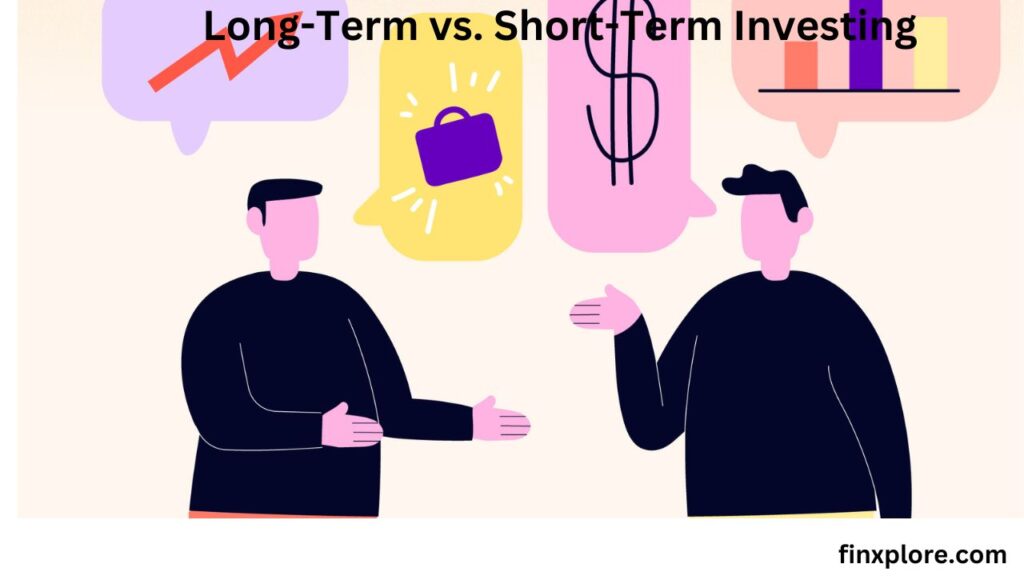Investing is an important tool for growing wealth, but deciding between long-term vs. short-term investing can be challenging. Each approach has its advantages, risks, and benefits depending on your financial goals. In this post, we’ll help you understand the difference between these strategies and guide you in making the right choice for your future.

What Is Long-Term Investing?
Long-term investing is when you purchase assets such as stocks, bonds, or real estate with the intention of holding them for several years or even decades. This strategy focuses on steady, compound growth over time. The idea is to let your investment increase in value through market appreciation, dividends, or interest.
Key Features of Long-Term Investing
Investment Horizon: 5 years or more.
Objective: Build wealth gradually by holding onto investments for extended periods.
Risk: Less risky over time as short-term volatility evens out.
Patience: You need to hold your investments and resist the temptation to sell during market fluctuations.
One of the best-known long-term investors is Warren Buffett, who believes in buying solid, well-performing stocks and holding them for years. This strategy reduces the need to constantly monitor the market and minimizes emotional decision-making.
Benefits of Long-Term Investing
1..Compound Growth: The longer you hold onto your investment, the more you benefit from compounding, which is when your gains earn even more returns.
2.Reduced Stress: You don’t have to monitor market movements daily.
3.Lower Taxes: In many countries, long-term capital gains are taxed at a lower rate.
4.Lower Costs: Fewer transactions mean fewer fees for buying and selling.
Example of Long-Term Investing
Imagine investing $1,000 in Apple stock today and holding it for 10 years. If the stock grows consistently, your investment could multiply without much effort. The key is patience and allowing your investments to grow over time.
What Is Short-Term Investing?
Short-term investing, on the other hand, focuses on making quick profits by buying and selling assets within a shorter period, typically less than a year. This strategy requires constant attention to market trends and news to capitalize on price movements.
Key Features of Short-Term Investing
Investment Horizon: Less than 1 year.
Objective: Take advantage of quick price movements for faster returns.
Risk: Higher due to market volatility.
Active Monitoring: Requires you to closely track the market and make rapid decisions.
Benefits of Short-Term Investing
1.Quick Gains: If you invest in the right stocks or assets, you can make money faster than with long-term investments
2.Profit from Trends: Short-term investors use current market trends, news, and analysis to make decisions.
3.Flexibility: You can switch investments quickly to adapt to the market.
Example of Short-Term Investing
Let’s say you buy shares in a company after hearing positive news about a new product launch. The stock price rises rapidly, and you sell your shares after three months, making a quick profit. However, the reverse can also happen, where bad news can cause stock prices to fall quickly.
Long-Term vs. Short-Term Investing: Which Is Right for You?
Choosing between long-term and short-term investing depends on several factors like your financial goals, risk tolerance, and how much time you can dedicate to managing your investments.
1. Your Financial Goals
Long-Term Investing: Best suited for long-term goals like retirement or saving for a home. If you’re planning for something more than five years down the road, long-term investing is ideal.
Short-Term Investing: If you need money in the next few months or years, short-term investing might be better. For instance, if you’re saving for a vacation or a new car.
2. Risk Tolerance
Long-Term Investing: Lower risk because, over time, markets tend to recover from downturns.Short-Term Investing: Higher risk since markets can fluctuate in the short term, but also the potential for higher rewards.
3. Time Commitment
Long-Term Investing: Requires minimal effort once your investments are set. You can “set it and forget it.”Short-Term Investing: Demands constant monitoring of the market, which can be time-consuming and stressful.
Combining Both Strategies
Many investors choose to combine both long-term and short-term investing. By diversifying your investments, you can achieve a balanced portfolio that benefits from both steady growth and quick gains. For example:
- Invest 80% of your portfolio in long-term investments like index funds.
- Use the remaining 20% for short-term trades or more speculative investments.
Optimizing Your Investment Strategy
Before deciding on a strategy, ask yourself these key questions:
- What are my financial goals?
- How much risk am I willing to take?
- How much time can I dedicate to managing my investments?
Conclusion
Both long-term and short-term investing can help you build wealth, but the best choice depends on your individual needs. Long-term investing provides stability and compound growth, perfect for retirement or large financial goals. Short-term investing offers the chance for quick profits but comes with higher risks and requires constant attention.
A balanced investment approach might include both strategies, allowing you to grow wealth over time while also taking advantage of short-term opportunities. No matter which strategy you choose, the most important thing is to stay informed, manage risk, and align your investments with your personal financial goals.
